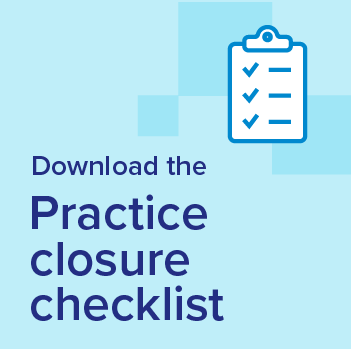Closing your practice: transition and retirement
Learn about your medical and professional responsibilities when you close your practice
What’s involved with closing a practice?
We have developed an online tutorial to give you all of the information you need when closing your practice, including your legal obligations.
Watch the webinarIf you think you would like to close your practice, it’s never too early to start planning.
There are a number of patient, legal, business, financial and professional obligations to consider and, depending on your type of practice, the Ontario Medical Association recommends a timeline of 12 to 24 months. Learn more about the suggested timelines for closing a practice.
As you begin the planning process, reflect on why you want to close your practice. You may be looking to retire, relocate, reduce your patient load or relaunch your career in another capacity.
Depending on your needs, there may be different options, including:
- Closing your practice
- Retiring gradually over a given time frame
- Reducing your hours and working part-time
- Engaging locum resources
- Selling your practice to another physician
If you need to close your practice unexpectedly, due to a sudden illness or another reason, consult the unexpectedly closing a practice resource guide.
As you prepare for your departure, the OMA encourages you to seek advice about your specific situation by:
- Talking to colleagues who have closed or left a practice. They can offer tips, help you avoid pitfalls, and raise issues you may not have considered
- Consulting with professionals such as a lawyer and an accountant, who can help you identify and tie up loose ends
Understanding what’s involved will ensure you effectively handle your responsibilities and have a smooth transition to the next phase in your life or career.
Closure considerations
Conversations with colleagues
OMA products and services
Frequently asked questions
Conversations with colleagues video series
Physicians share their experiences with closing their practice in these videos.
Planning on closing your medical practice
Physician colleagues discuss wrapping up their practice.
Succession planning and retirement
Physicians discuss success planning.
Additional products and services available for members
OMA members get access to exclusive savings from our partners. Explore these relevant resources, products and services.
Legal disclaimer
The information on this page has been made available for informational and educational purposes only and does not replace independent legal advice. These resources contain the views and opinions of the Ontario Medical Association regarding the interpretation of the College of Physician and Surgeons Policies and Ministry of Health regulations. Members are advised that the ultimate authority in matters of interpretation are in the purview of the CPSO and the MOH. The OMA assumes no responsibility for any discrepancies or differences of interpretation, any applicable law, or regulation with the Government of Ontario including but not limited to the MOH and the CPSO.
